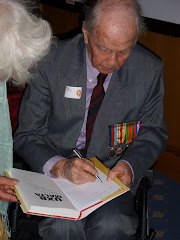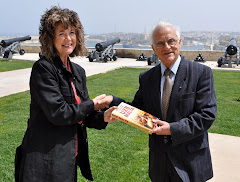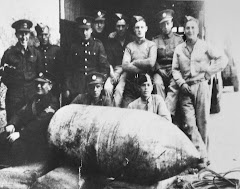“No. 400411 A/Lt E. E. A. C. Talbot. RE, GC, MBE (attached RAF) reported missing, believed killed whilst flying over Sicily. For the last weeks he had been acting as Liaison Officer to RAF at the Bomber Aerodrome, Luqa.”
In a few words, the Royal Engineers War Diary for Malta recorded the tragic loss of an excellent Bomb Disposal Officer and a well-liked man.
Lt Edward Talbot had arrived in Malta in November 1940 to take charge of all Army bomb disposal work for Malta (and Gozo). Since Italy had declared war in June 1940, Malta had been the focus for frequent bombing attacks of increasing intensity. It was time for the Island to have proper arrangements for dealing with unexploded bombs and Lt Talbot was given the task of establishing its first Royal Engineers Bomb Disposal Section.
Ellis Edward Arthur Chetwynd Talbot was born in 1920 and brought up in Shropshire. Educated at Harrow School, in 1938 he went up to Trinity Hall, Cambridge, to study Engineering. When war against Germany was declared, Talbot volunteered for the Royal Engineers; he was appointed 2nd Lieutenant in October 1939.
In August 1940, Talbot was leading No.103 Bomb Disposal Section, in South Wales. On Sunday 25 August, Lt Talbot’s squad uncovered an unexploded bomb near a railway track near Loughor. It had a new and unknown type of fuze; there was a real possibility it was a booby-trap. Special equipment was needed from London – but it would not arrive until next morning and meanwhile a vital railway line was under threat. Talbot decided he must do something and, despite the risk, picked up the bomb and carried it away on his shoulder. Lt Talbot’s action earned him the Empire Gallantry Medal (converted to a George Cross). Before his squad had time to celebrate, Talbot was on his way to Malta.
The next four months were busy: from 1 December 1940, Lt Talbot and his Bomb Disposal Section received 96 UXB reports and dealt with ten tons of bombs: forty high explosives, nine incendiaries and ten Ack-Ack shells. It was a considerable achievement for one Bomb Disposal Section operating alone – though merely a foretaste of what was to come in Malta. For his work clearing UXBs from the aerodromes at Hal Far and Luqa during February and March 1941, Talbot was awarded the MBE.
In May 1941, after six months in post, Lt Talbot had earned the right to a respite, and the responsibilities of Bomb Disposal Officer for Malta was handed over to Lt George Carroll. However, with pressure on the Island’s military resources increasing, no able officer could rest for long. Lt Talbot was given a new appointment, as liaison officer between the Army and the RAF.
On 10 October 1941, Lt Talbot boarded RAF Blenheim ZL7638, one of four Blenheims from 107 Squadron based at RAF Luqa and sent to attack ships off the coast of Southern Italy. Lt Talbot’s plane was piloted by Wing Commander F A Harte, DFC. Some time later, two of the Blenheims returned, forced to turn back due to engine trouble. Hours passed with no sign of the other two aircraft. Eventually, the Operations room at Luqa reluctantly chalked them up as missing. Then RAF intelligence monitoring picked up something from Italian radio. A report was saying that two RAF Blenheims were observed colliding in mid-air off the coast, while taking evasive action under enemy fire. If the Italian report was accurate, there was only one possible conclusion.
The loss was of Edward Talbot was not only a blow to the Royal Engineers Bomb Disposal establishment, it was a personal tragedy to Lt Carroll, who was deeply affected by the death of a man who had become his friend:
“Because Edward didn’t have a job any more, after I had taken over, he got attached to the RAF as an Intelligence Officer. He was taking in reports of returning pilots and he decided that, with this responsibility, he should know something about what it was like to be on a raid. So he volunteered and went off, in a Blenheim I think, and didn’t come back. That was how he lost his life, after being in Bomb Disposal.”
Lt Ellis Edward Chetwynd Talbot, GC, MBE was buried in the Catania War Cemetery in Sicily. He was 21 years old.
Monday, 10 October 2011
Sunday, 12 June 2011
BBC Radio 4 Broadcasting House Sunday 12 June 2011
UXB Malta,S. A. M. Hudson, ISBN 9780752456355, published by History Press 2010. Available from www.thehistorypress.co.uk, and from all leading booksellers.
“I climbed up to where the bomb was and lay down beside it. Then I took my rake and was scraping away gently to find the fuze. Then suddenly the bomb fell, right in front of my eyes…I died.
I was expecting it to explode - and it didn't.
It bounced across the road and it the ground again. I died again.
And then it rolled...across the ground. And with each roll it could go off. And it didn't.
I look upon myself as being very lucky that day."
Former Royal Engineers bomb disposal officer George Carroll, 93, talks about his World War 2 experiences to Radio 4's Paddy O'Connell. In a moving interview he reveals for the first time the true effect of tackling hundreds of unexploded bombs and his diagnosis of PTSD in 2009. Lt Carroll served in the blitz on London and then for over a year in Malta, including four months of intensive bombardment when the Island became 'the most bombed place on earth'.
To hear the interview go to
http://www.bbc.co.uk/iplayer/episode/b011tw7g/Broadcasting_House_12_06_2011
“I climbed up to where the bomb was and lay down beside it. Then I took my rake and was scraping away gently to find the fuze. Then suddenly the bomb fell, right in front of my eyes…I died.
I was expecting it to explode - and it didn't.
It bounced across the road and it the ground again. I died again.
And then it rolled...across the ground. And with each roll it could go off. And it didn't.
I look upon myself as being very lucky that day."
Former Royal Engineers bomb disposal officer George Carroll, 93, talks about his World War 2 experiences to Radio 4's Paddy O'Connell. In a moving interview he reveals for the first time the true effect of tackling hundreds of unexploded bombs and his diagnosis of PTSD in 2009. Lt Carroll served in the blitz on London and then for over a year in Malta, including four months of intensive bombardment when the Island became 'the most bombed place on earth'.
To hear the interview go to
http://www.bbc.co.uk/iplayer/episode/b011tw7g/Broadcasting_House_12_06_2011
Tuesday, 15 February 2011
CALLING FAMILIES OF RE BOMB DISPOSAL MALTA
These pages have brought their first reunion between the author and the family of a member of RE Bomb Disposal, Malta, thanks to a comment by Pauline Godwin about her father, L/Sgt Rowland Hilliar, on these pages last year. He never spoke to them about his work in bomb disposal but now the family have read UXB Malta they can be justly proud of his achievements.
It is hoped that other families will do the same, and learn how these men coped in extraordinary circumstances to deal with thousands of unexploded bombs. All of the Royal Engineers Bomb Disposal Officers who served in Malta during World War 2 are named below, taken from official records and War Diaries of 1940-44.
The list of Other Ranks (with Army Service Numbers in brackets, where known) is based only on available secondary information, so it may not be completely accurate.
If you recognise any names, or have any questions, please use the Comments section to get in touch.
Lt Ellis Edward Arthur Chetwynd Talbot (served November 1940 to May 1941)
Lt George Daniel Carroll (served April 1941 to April 1942)
Lt Thomas Walter Townsend Blackwell (served December 1941 to February 1943)
Lt Frederick William Ashall (served April to July 1942)
Lt Thomas Whitworth (served July 1942 to November 1944)
Lt Henry Lavington (served February to October 1943)
OTHER RANKS
Members of 24 Fortress Company, Royal Engineers believed to have served in Malta’s Bomb Disposal Sections during World War 2.
NON-COMMISSIONED OFFICERS
Sgt Holland (102309)
Sgt Reginald Charles Parker (1871236)
Sgt Thomas Piggott (1863676)
L/Sgt Cecil Arthur Brewer (1866450)
L/Sgt George Henry King (1864077)
L/Cpl Rowland Hilliar (1873804)
L/Cpl Cyril Thomas Meager (1872626)
SAPPERS
Spr Joseph Birchenall (1872550)
Spr George Codling
Spr Robert Cushen
Spr Rex Garvin
Spr Thomas Hammond (1872638)
Spr James Lee Leonard (858620)
Spr Lockyer
Spr Duncan MacDonald (1871171)
Spr Daniel McCarthy (1875751)
Spr Laurence Miller (1875725)
Spr Rattenbury
Spr Henry James Reeves (1877565)
Spr C E Reeves (“Inky”)
Spr William Douglas Scott (1871172)
Spr Harry Turner (1875560)
Spr Robert Henry Walter (1873669)
It is hoped that other families will do the same, and learn how these men coped in extraordinary circumstances to deal with thousands of unexploded bombs. All of the Royal Engineers Bomb Disposal Officers who served in Malta during World War 2 are named below, taken from official records and War Diaries of 1940-44.
The list of Other Ranks (with Army Service Numbers in brackets, where known) is based only on available secondary information, so it may not be completely accurate.
If you recognise any names, or have any questions, please use the Comments section to get in touch.
Lt Ellis Edward Arthur Chetwynd Talbot (served November 1940 to May 1941)
Lt George Daniel Carroll (served April 1941 to April 1942)
Lt Thomas Walter Townsend Blackwell (served December 1941 to February 1943)
Lt Frederick William Ashall (served April to July 1942)
Lt Thomas Whitworth (served July 1942 to November 1944)
Lt Henry Lavington (served February to October 1943)
OTHER RANKS
Members of 24 Fortress Company, Royal Engineers believed to have served in Malta’s Bomb Disposal Sections during World War 2.
NON-COMMISSIONED OFFICERS
Sgt Holland (102309)
Sgt Reginald Charles Parker (1871236)
Sgt Thomas Piggott (1863676)
L/Sgt Cecil Arthur Brewer (1866450)
L/Sgt George Henry King (1864077)
L/Cpl Rowland Hilliar (1873804)
L/Cpl Cyril Thomas Meager (1872626)
SAPPERS
Spr Joseph Birchenall (1872550)
Spr George Codling
Spr Robert Cushen
Spr Rex Garvin
Spr Thomas Hammond (1872638)
Spr James Lee Leonard (858620)
Spr Lockyer
Spr Duncan MacDonald (1871171)
Spr Daniel McCarthy (1875751)
Spr Laurence Miller (1875725)
Spr Rattenbury
Spr Henry James Reeves (1877565)
Spr C E Reeves (“Inky”)
Spr William Douglas Scott (1871172)
Spr Harry Turner (1875560)
Spr Robert Henry Walter (1873669)
Monday, 10 January 2011
UXB Malta is Editor's Choice, Britain at War Magazine December 2010
Britain at War Editor Martin Mace has chosen UXB Malta as his feature of the month in the latest issue of the magazine. Five pages of photographs and extracts from the book highlight the challenges faced by Malta's handful of Royal Engineers Bomb Disposal men during World War Two. Their achievements are set in the context of round-the-clock bombardment by a determined Luftwaffe, who flew over 9,500 sorties against the Island in one month alone as part of a continuous 154 days of air raids (compared to 57 days of the London Blitz.
The article also focuses on the exploits of Lt George Carroll, Bomb Disposal Officer for Malta at the height of the siege, who served continuously through the toughest months of the bombing, working through over 2,000 alerts. Lt Carroll's memories are among the many personal stories collected by the author in what is a remarkable story of human achievement.
Copies of the magazine are available via the website www.britain-at-war-magazine.com or from Britain at War, P) Box 2068, Bushey, Hertfordshire, WD23 3ZF. Email: britainatwar@alliance-media.co.uk.
The article also focuses on the exploits of Lt George Carroll, Bomb Disposal Officer for Malta at the height of the siege, who served continuously through the toughest months of the bombing, working through over 2,000 alerts. Lt Carroll's memories are among the many personal stories collected by the author in what is a remarkable story of human achievement.
Copies of the magazine are available via the website www.britain-at-war-magazine.com or from Britain at War, P) Box 2068, Bushey, Hertfordshire, WD23 3ZF. Email: britainatwar@alliance-media.co.uk.
Subscribe to:
Comments (Atom)






